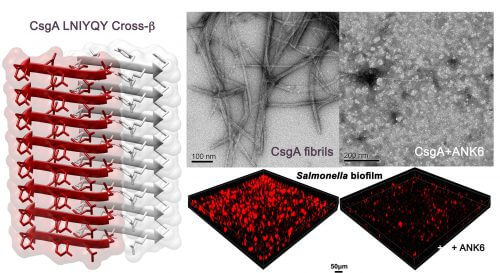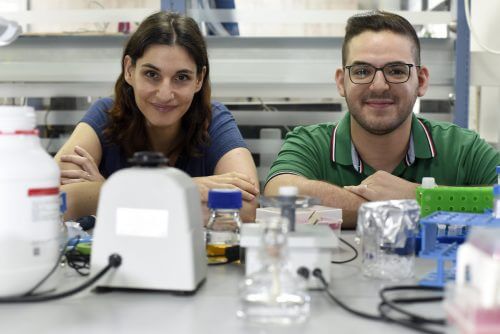They intend to continue research and develop innovative treatments that will neutralize violent bacteria that are resistant to antibiotics

Prof.-member Mittal Landau and PhD student Nir Selins from the Faculty of Biology at the Technion succeeded in damaging the creation of a biofilm of Salmonella bacteria. Biofilm is a resistant membrane that is a serious medical and environmental problem because it protects the bacteria and allows them to stick to tissues, pipes, surfaces, medical equipment and more. The researchers' discovery is expected to lead to the development of innovative treatments that will inhibit antibiotic resistance among violent bacteria.
In 2017, Prof. Landau's research team published, in the journal Science, new discoveries about Staphylococcus aureus - a particularly violent bacterium that has developed resistance to many strains of antibiotics and is responsible for a significant portion of the infection cases that occur in hospitals and in the community. The researchers discovered that this bacterium, which attacks the organism's cells and its immune system, does so partly through unique fibers it secretes. These toxic fibers resemble amyloids, proteins associated with neurodegenerative diseases such as Alzheimer's and Parkinson's, but differ from them structurally. In an article published in 2018 in the journal Nature Communication, Salinas and his colleagues in the research team discovered that proteins from the same family of the toxic fiber create very stable amyloid structures, which last under very harsh conditions and protect the bacteria. Prof. Landau expressed hope that these discoveries will lead to new treatments that will damage the fibers and significantly reduce the aggressiveness of severe infections caused by Staphylococcus aureus.
Now, in a study published in the journal PLoS Pathogens, the Technion researchers discovered that damage to the amyloid fibers produced by E. coli and Salmonella bacteria, which are involved in food contamination, damages the bacteria's defense mechanisms and their ability to adhere to tissues and medical devices. This is through the repurposing of materials that have already undergone clinical trials for the treatment of Alzheimer's. The great advantage of re-designation is that the approval process is much shorter and cheaper than that of a new drug.
The substances tested on the salmonella bacterium do not harm the bacterium directly; They damage the biofilm, which is, as mentioned, a resistant membrane that protects the bacteria from substances that endanger them, including antibiotic drugs. The researchers estimate that the damage to the biofilm will not lead to the development of resistance because it does not force the bacteria to defend their lives. This is in contrast to antibiotics, the use of which increases the resistance of the bacteria and its violence.
Although the research focused on salmonella and E. coli bacteria, which are associated with food infections, the researchers hope that it will also be useful in the fight against other bacteria, including Staphylococcus aureus. In the continuation of his doctoral research, Salinas will focus on the development of stable antibacterial substances and the screening of small molecules that will inhibit the formation of amyloid fibers in bacteria. He hopes that such developments will accelerate the vital fight against the development of violent strains of bacteria that are resistant to antibiotics.

Researchers from the Institute for Complex Systems in Licht and Dusseldorf, Germany, are partners in the study. At the Technion, the Center for Structural Biology, the Lori Lockey Center for Life Sciences and Engineering, the Center for Electron Microscopy (MICA) and the Center for Electron Microscopy of Soft Matter at the Russell Berry Institute for Nanotechnology assisted in this work.
Prof. Mittal Landau joined the Technion faculty after a post-doctorate at the University of California Los Angeles (UCLA), where she specialized in X-ray microcrystallography and amyloids related to Alzheimer's disease. In September 2012, she established her own laboratory in the Faculty of Biology at the Technion.
Nir Salinas completed a bachelor's degree in molecular biochemistry at the Technion in the Shulich Faculty of Chemistry and is currently on a direct path to a doctorate in the Biology Faculty.
For the full article in PLoS Pathogens
More of the topic in Hayadan:
